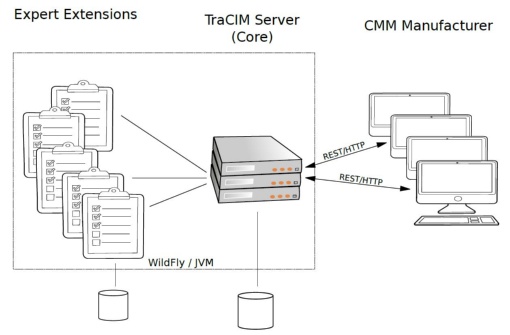A part of computer science has its roots in the field of applied mathematics. The term "computer" of course comes from the verb "to [mathematically] compute". As a calculator, a computer nowadays usually fulfils basic arithmetic operations at a hardware level, and further functions – such as trigonometric functions – are implemented in the standard libraries of programming languages, such as FORTRAN, C or Java. There are also libraries for more complex functions, but not for all such functions. Certain functions and procedures must therefore be programmed explicitly, whereby the verification of the correctness of the calculation process can be very complicated and extensive, once the calculation is beyond a certain level of complexity.
One area of application of such complex procedures comprises coordinate-measuring machines, which are used in industrial production, for example, to check manufacturing tolerances. The sensors take recordings at measuring points, and the length, area or volume of the object to be measured is calculated by software-implemented procedures. The sensors operate using tactile, optical and even x-ray-tomography measures, down to the level of micrometres. One such well-known calculation method is the method of least-squares, based on foundations laid by Carl Friedrich Gauss as far back as 1795, and is thus about 200 years old.
The research project TraCIM (Traceability for Computational-Intensive Metrology) ran from June 2012 to May 2015 in the framework of the European Metrology Research Program (EMRP), with the aim of, for example, validating and certifying the method of least-squares, which is used by software in coordinate-measuring machines. Public-authority certificates are issued by national metrology institutes (NMIs). Within the scope of the TraCIM project, the national metrology institutes of Germany (PTB), the United Kingdom (NPL), the Czech Republic (CMI), Italy (INRIM), Slovenia (UM) and the Netherlands (VSL) worked on this type of certification question.
Other project partners were the University of Huddersfield, University of Applied Sciences Zwickau, the University of York, as well as the Ostfalia. At the Ostfalia, the work was undertaken at the Institute for Software Engineering within the Faculty of Computer Science/IT, under the direction of Prof. Dr. Bernd Müller. The Ostfalia was responsible for the entirety of the software-side solution, while the metrology institutes and the other universities worked on the mathematical issues. TraCIM's partners from the world of industry were Hexagon, Mitutoyo, Werth and Zeiss – the global market leader in the field of coordinate-measuring machines.
 The modell of the server application
The modell of the server application
The server application developed by Ostfalia consists of an administration core and "expert extensions", which effect the respective mathematical methods. The architecture is shown in the figure. The application, which has been productively operated at the Physikalisch Technische Bundesanstalt in Braunschweig, Germany since 2014, currently presents the procedures of Gauss and Chebyshev. In addition, an inter-comparison procedure was prepared using the three appropriate expert extensions. The typical use of the system is as follows: a coordinate-measuring-machine manufacturer, using standard Internet protocols, requests the relevant test data for one of the three procedures. After checking the administrative and economic boundary conditions, it receives the corresponding test data and uses this as input data for its software to be certified. The result of the calculation is sent back to the PTB, where the corresponding expert extension compares the submitted results with those expected. If, in a specific tolerance report, the results are in agreement with each other, the device manufacturer receives a certificate for the tested version of its software. In the meantime, all four coordinate-measuring-machine manufacturers involved in the project have had several versions of their software certified in this way. The number of other certifications is in the high double digits.
In the follow-up project, ValTraC (Validation of Software Development and Analysis Tools using TraCIM, also funded by EMPR), the Physikalisch-Technische Bundesanstalt (PTB), the National Physical Laboratory (NPL), the Ostfalia and National Instruments (as a partner from the industrial sector) worked on validating and certifying further mathematical procedures, independent of issues around coordinate-measuring machines. The project ran from July 2016 to December 2017 and allows the NPL to offer commercial certification involving 6 calculation methods to date, which can be used for example by National Instruments for LabVIEW.
Please contact Prof. Dr. Bernd Müller for more information.